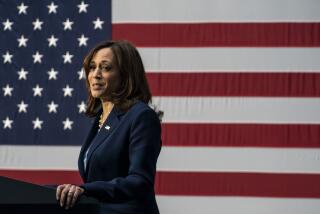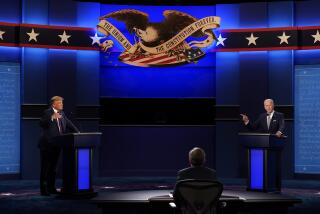As Trump expands travel restrictions to U.K. and Ireland, he tests negative for coronavirus, doctor says

- Share via
WASHINGTON — President Trump on Saturday urged Americans to avoid flying to slow the spread of the new coronavirus and expanded the U.S. ban on travel from Europe to include the United Kingdom and Ireland.
“If you don’t have to travel, I wouldn’t do it,” Trump said at a White House news conference. “We want this thing to end. We don’t want a lot of people getting infected.”
The president also revealed that he’s been tested for the virus even though a letter from his physician the previous evening said it was not necessary. The White House announced later in the day that Trump tested negative.
“The President remains symptom-free,” said the memo from his physician, Sean P. Conley.
Saturday’s remarks capped a remarkable shift in tone over the past few days for Trump, who once downplayed the threat of the coronavirus and now boasts about his efforts to fight it. Wearing a campaign hat emblazoned with “USA” in the front and “TRUMP” in the back, he bragged about the stock market rally that followed his declaration of a national emergency the previous day and said the crisis had created “a number of new stars” among his administration’s health officials.
“We’re using the full power of the federal government to defeat the virus,” Trump said.
The expanded travel ban for the U.K. and Ireland — which adds to the restrictions placed this week on most other European countries — takes effect on Monday at midnight and does not effect U.S. citizens.
The White House was also tightening procedures around the building. Reporters had their temperatures checked before entering Saturday’s news conference, and one was turned away because it was too high. Checks are being conducted “on any individuals who are in close contact with the president and vice president,” according to a White House spokesman.
Trump praised Congress for reaching a bipartisan deal responding to the coronavirus crisis, including an expansion of paid sick leave and financial support for struggling businesses.
“It was very nice to see it,” the president said.
Trump even had some praise for the media, a favorite target of his, saying it “has been very fair for the most part” in its reporting on the coronavirus.
“We’re all in this together,” he said.
Trump has stopped suggesting that the number of coronavirus infections might decrease as health officials brace for a potential crush of cases at hospitals around the country.
There are about 3,000 confirmed coronavirus cases in the United States and at least 57 deaths.
“We have not reached our peak,” said Dr. Anthony Fauci, director of the National Institute of Allergy and Infectious Diseases. “We will see more cases, and we will see more suffering and death.”
Trump pledged to continue taking aggressive new steps to slow the spread of the virus, but his administration’s response remained strained by mixed messages.
During his Saturday news conference, Trump said domestic travel restrictions were being considered “specifically from certain areas.” Three hours later, a senior official at the Department of Homeland Security said there were no plans for any such limits.
“There’s no expectation of any domestic travel restrictions at this time,” said the official, who spoke to reporters on the condition of anonymity.
In addition, Trump said Friday that Google was developing a website that would help Americans determine whether they need a coronavirus test and where they can get one. But Verily, a subsidiary of Google’s parent company, said that the website was only a pilot project intended for the San Francisco Bay Area. It could be launched nationwide at some point in the future.
Vice President Mike Pence said more information would be shared Sunday about when the website would be available and where Americans could visit drive-up testing sites to see if they’ve contracted the coronavirus.
The issue of whether Trump would personally take a test has been emblematic of his administration’s shaky response to the coronavirus. Any doubt about a president’s health can rattle the public and the financial markets, which are already badly shaken by the pandemic. Last weekend at Trump’s Mar-a-Lago resort in Florida, the president came into contact with multiple Brazilian officials who tested positive for the virus.
On Friday, Trump downplayed the chance that he was exposed even though he posed for a picture with one of the officials.
“I take pictures and it lasts for, literally, seconds,” he said. “I don’t know the gentleman that we’re talking about.”
Later, when asked if he was “being selfish by not getting tested and potentially exposing” others, Trump shifted course, saying he would “most likely” get tested “fairly soon.”
But later that evening the White House released a letter from Conley, a Navy commander and osteopathic doctor assigned to the president, who said it wasn’t necessary for Trump to take a test. He was at “low risk,” Conley wrote.
Trump apparently received the test anyway.
“I also took the test last night,” Trump said on Saturday. “I decided I should based on the press conference last night.”
Several hours later, the White House announced that the test came back negative.
More to Read
Get the L.A. Times Politics newsletter
Deeply reported insights into legislation, politics and policy from Sacramento, Washington and beyond. In your inbox twice per week.
You may occasionally receive promotional content from the Los Angeles Times.












